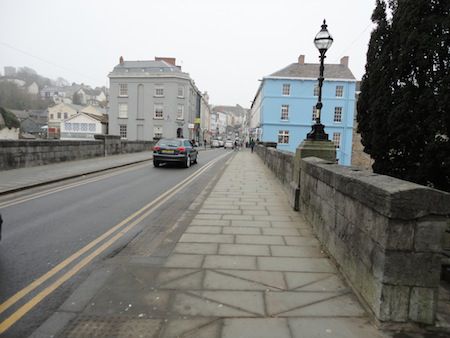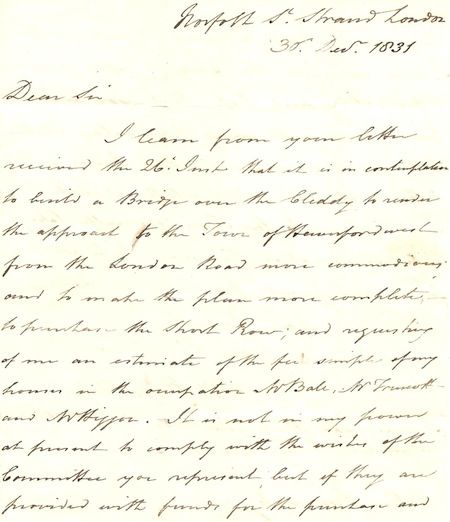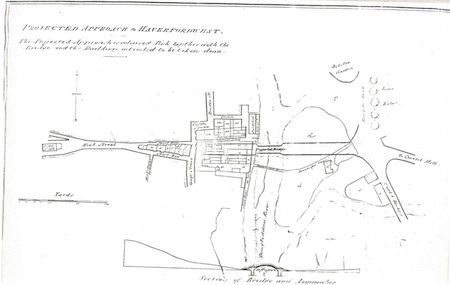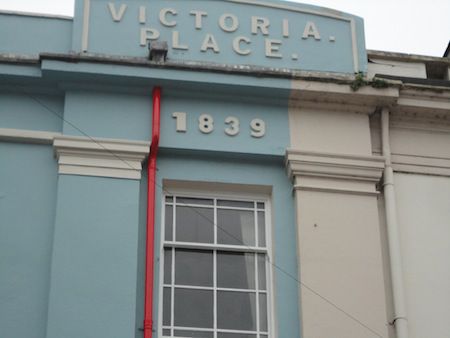New Bridge, Haverfordwest
16th January 2015

New Bridge built and financed by William Owen in 1836
In 1834 a committee was formed and given the task of selecting a site for a new County Law Court in Haverfordwest. Prior to this date, these activities had been housed in the Guildhall situated at the top of High Street, in front of St Mary’s Church. Long considered a decaying embarrassment to visiting judges, it was intended that the new building would overcome the, ‘insufficiency, inconvenience and deficiency’ of the old Guildhall.
Various locations were examined including the site in St Mary’s Street now occupied by the Temperance Hall. On 17th January 1835, a report was submitted by the Chairman, Thomas Martin, which recommended the acquisition of the area at the bottom of High Street, it being deemed essential that the position of this new edifice was as close to the town centre as possible.
It has long been vaguely suggested that the building of the New Bridge was motivated by the decision to build the Shire Hall in this position and to have a prestigious entrance into the town and of course to the new Law Courts for the judges.
However, a number of the letters that form the remarkable collection of Norman Jones, (some of which, you may recall, I’ve drawn on before) spanning over three centuries, show that the decision to build the bridge along with the re-shaping of the town that would be a consequence, was well under way long before the decision for the positioning of the Shire Hall had been taken.

Letter dated Dec. 1831, from ‘Short Row’ property owner Mr Phillips, of The Strand, London, to Haverfordwest Borough Council.
Courtesy of Norman Jones
On 30 December 1831 a (quite arrogant) letter arrived at the offices of Haverfordwest Borough Council, addressed to the Town Clerk, Mr Arthur Bowen, from Mr Phillips, Norfolk Street, Strand, London. He is answering a letter, written just four days before, from the council that has obviously invited him to sell properties that he owns in what was known as Short Row with the main reason given that a New Bridge is planned. (Short Row was a collection of business properties positioned in the centre of the lower half of High Street.)
Dear Sir,
I learn from your letter received the 26th Inst that it is in contemplation to build a bridge over the Cleddy to render the approach to the Town of Haverfordwest from the London Road more commodious and to make the plan more complete, to purchase the Short Row and requesting of me an estimate of the fee simple of my houses in the occupation of W Bale, W Truscott and W Higgon. It is not in my power at present to comply with the wishes of the Committee you represent but if they are provided with funds for the purchase and they are enabled to carry it into execution I will consider the subject upon receiving information and hope that you will favour me with every particular relative to the proposed measure that I may be the better enabled to judge whether it will be of advantage to the Town favourably, taking into consideration the plan to be adopted for raising funds for the occasion.
I am dear sir
Your obedient servant
Phillips
I must add that your letter was the first Information I had upon the subject.

This is a plan of the proposed alterations to the town to accommodate the building of the New Bridge. It was sent to London, to the property owner described in the letter, in 1832.
Courtesy of the County Archives
On the 9 January 1832 the Council responded by sending Philipps a plan of the proposed bridge position and the enormous alterations that would be required. Philipps responded on the 30th January in a short letter saying that he wanted still more information in respect of funding the whole new town plan project.

This shows the date memorialising the building of Victoria Place which had to happen once the New Bridge was built and involved demolishing a huge amount of property
Whatever the council’s response was after that must have satisfied Mr Philipps because the Short Row properties were purchased (for £1356) and demolished, as was the Quaker Meeting House which stood where the Shire Hall is now. In addition, properties had to be acquired and demolished in order to build Victoria Place and expand Castle Square.
With the Council running low on funds, William Owen funded the building of the New Bridge himself and was allowed to run it as a toll bridge until the 1880s. The bridge was complete by 1836, Victoria Place by 1839.
The County Council is finally recognising the embarrassing tragedy of having disposed of The Shire Hall with efforts being made to reacquire it.